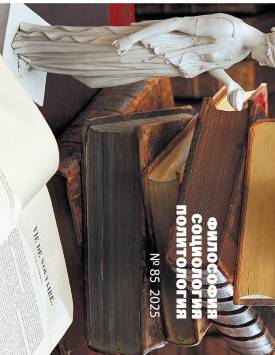The enlightenment project of modernity: François Quesnay's economic table as a tool for modeling the future
Problematizing the ordinary understanding of modernity, which equates it solely with the living experience of the present moment, the author proposes to view modernity as a distinct philosophical concept that first emerged in the history of Western thought during the Enlightenment. As such, it was originally embedded within a unique Enlightenment paradigm of temporal perception, where the present was understood in an inseparable connection with a better future and contrasted with a pre-critical past. Broadly speaking, the specificity of this paradigm can be described through three key elements: progressivism, an active orientation toward the future, and the simultaneity of non-simultaneous phenomena. The first element presupposes an unconditional belief in the possibility of achieving a better future. The second implies the adoption of an attitude that heroizes the present, within which the future becomes directly dependent on decisions made in the present moment. Finally, the third requires considering a complex of phenomena occurring at different moments of time as coexisting simultaneously, that is, within a unified historical space. From the author’s perspective, all these elements can be identified in the political-economic doctrine of the physiocrats, particularly in the works of Francis Quesnay, namely in his “Economic Table”. By analyzing the genesis of Quesnay’s views on the general principles of the table and comparing its classical version with his earlier works on physiology, the author concludes that Quesnay’s ultimate goal was to visually represent the natural mechanism of capital reproduction, thereby justifying the possibility of its controlled renewal in the future. By situating different temporal moments within a single visual-mathematical space of the table, Quesnay not only substantiates the possibility of the French economic system’s normal functioning in the present but also vividly demonstrates its potential for future prosperity. Thus, the economic table established a distinct active orientation toward the future, expressed not only in critical theorizing but also in justifying the necessity of direct political action. According to the author, this interpretation of the goals and tasks of Quesnay’s project, on the one hand, situates it within the broader context of progressivist thought and, on the other, allows us to view the economic table as a unique macroeconomic tool designed to model a better future. The author declares no conflicts of interests.
Keywords
Enlightenment, modernity, future, physiocracy, economic tableAuthors
| Name | Organization | |
| Kornienko Alexej G. | Saint Petersburg State University | akornienko@spbu.ru |
References

The enlightenment project of modernity: François Quesnay's economic table as a tool for modeling the future | Tomsk State University Journal of Philosophy, Sociology and Political Science. 2025. № 85. DOI: 10.17223/1998863X/85/6
